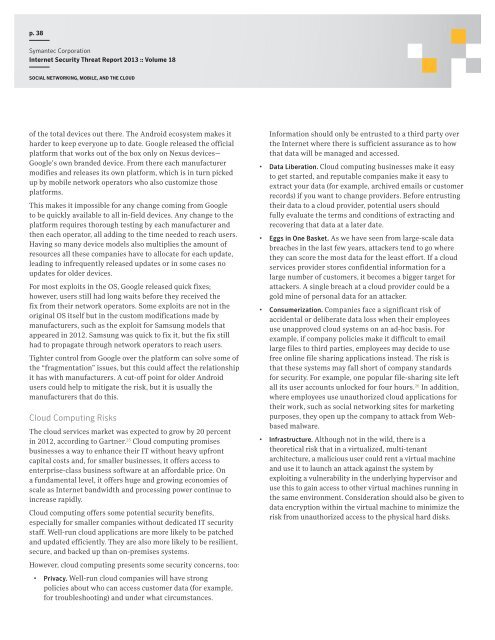internet security tHreAt rePOrt GOVernMent 2013
internet security tHreAt rePOrt GOVernMent 2013
internet security tHreAt rePOrt GOVernMent 2013
You also want an ePaper? Increase the reach of your titles
YUMPU automatically turns print PDFs into web optimized ePapers that Google loves.
p. 38<br />
Symantec Corporation<br />
Internet Security Threat Report <strong>2013</strong> :: Volume 18<br />
SOCIaL NETWORkINg, MObILE, aNd ThE CLOUd<br />
of the total devices out there. The Android ecosystem makes it<br />
harder to keep everyone up to date. Google released the official<br />
platform that works out of the box only on Nexus devices—<br />
Google’s own branded device. From there each manufacturer<br />
modifies and releases its own platform, which is in turn picked<br />
up by mobile network operators who also customize those<br />
platforms.<br />
This makes it impossible for any change coming from Google<br />
to be quickly available to all in-field devices. Any change to the<br />
platform requires thorough testing by each manufacturer and<br />
then each operator, all adding to the time needed to reach users.<br />
Having so many device models also multiplies the amount of<br />
resources all these companies have to allocate for each update,<br />
leading to infrequently released updates or in some cases no<br />
updates for older devices.<br />
For most exploits in the OS, Google released quick fixes;<br />
however, users still had long waits before they received the<br />
fix from their network operators. Some exploits are not in the<br />
original OS itself but in the custom modifications made by<br />
manufacturers, such as the exploit for Samsung models that<br />
appeared in 2012. Samsung was quick to fix it, but the fix still<br />
had to propagate through network operators to reach users.<br />
Tighter control from Google over the platform can solve some of<br />
the “fragmentation” issues, but this could affect the relationship<br />
it has with manufacturers. A cut-off point for older Android<br />
users could help to mitigate the risk, but it is usually the<br />
manufacturers that do this.<br />
Cloud Computing Risks<br />
The cloud services market was expected to grow by 20 percent<br />
in 2012, according to Gartner. 25 Cloud computing promises<br />
businesses a way to enhance their IT without heavy upfront<br />
capital costs and, for smaller businesses, it offers access to<br />
enterprise-class business software at an affordable price. On<br />
a fundamental level, it offers huge and growing economies of<br />
scale as Internet bandwidth and processing power continue to<br />
increase rapidly.<br />
Cloud computing offers some potential <strong>security</strong> benefits,<br />
especially for smaller companies without dedicated IT <strong>security</strong><br />
staff. Well-run cloud applications are more likely to be patched<br />
and updated efficiently. They are also more likely to be resilient,<br />
secure, and backed up than on-premises systems.<br />
However, cloud computing presents some <strong>security</strong> concerns, too:<br />
• Privacy. Well-run cloud companies will have strong<br />
policies about who can access customer data (for example,<br />
for troubleshooting) and under what circumstances.<br />
Information should only be entrusted to a third party over<br />
the Internet where there is sufficient assurance as to how<br />
that data will be managed and accessed.<br />
• Data Liberation. Cloud computing businesses make it easy<br />
to get started, and reputable companies make it easy to<br />
extract your data (for example, archived emails or customer<br />
records) if you want to change providers. Before entrusting<br />
their data to a cloud provider, potential users should<br />
fully evaluate the terms and conditions of extracting and<br />
recovering that data at a later date.<br />
• Eggs in One Basket. As we have seen from large-scale data<br />
breaches in the last few years, attackers tend to go where<br />
they can score the most data for the least effort. If a cloud<br />
services provider stores confidential information for a<br />
large number of customers, it becomes a bigger target for<br />
attackers. A single breach at a cloud provider could be a<br />
gold mine of personal data for an attacker.<br />
• Consumerization. Companies face a significant risk of<br />
accidental or deliberate data loss when their employees<br />
use unapproved cloud systems on an ad-hoc basis. For<br />
example, if company policies make it difficult to email<br />
large files to third parties, employees may decide to use<br />
free online file sharing applications instead. The risk is<br />
that these systems may fall short of company standards<br />
for <strong>security</strong>. For example, one popular file-sharing site left<br />
all its user accounts unlocked for four hours. 26 In addition,<br />
where employees use unauthorized cloud applications for<br />
their work, such as social networking sites for marketing<br />
purposes, they open up the company to attack from Webbased<br />
malware.<br />
• Infrastructure. Although not in the wild, there is a<br />
theoretical risk that in a virtualized, multi-tenant<br />
architecture, a malicious user could rent a virtual machine<br />
and use it to launch an attack against the system by<br />
exploiting a vulnerability in the underlying hypervisor and<br />
use this to gain access to other virtual machines running in<br />
the same environment. Consideration should also be given to<br />
data encryption within the virtual machine to minimize the<br />
risk from unauthorized access to the physical hard disks.


